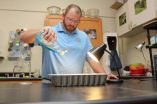(Press-News.org) Drawing from his engineering background, Princeton University researcher Alexandre Persat had a notion as to why the bacteria Caulobacter crescentus are curved — a hunch that now could lead to a new way of studying the evolution of bacteria, according to research published in the journal Nature Communications.
Commonly used in labs to study cell division, C. crescentus naturally take on a banana-like curve, but they also can undergo a mutation in which they grow to be perfectly straight. The problem was that in a laboratory there was no apparent functional difference between the two shapes. So a question among biologists was, why would nature bother?
Then Persat, who is a postdoctoral researcher in the group of Associate Professor of Molecular Biology Zemer Gitai, considered that the bacteria dwell in large groups attached to surfaces in lakes, ponds and streams. That means that their curvature could be an adaptation that allows C. crescentus to better develop in the water currents the organisms experience in nature.
In the new paper, first author Persat, corresponding author Gitai and Howard Stone, Princeton's Donald R. Dixon '69 and Elizabeth W. Dixon Professor of Mechanical and Aerospace Engineering, report that curvature does more than just help C. crescentus hold their ground in moving fluid. The researchers monitored C. crescentus growth on surfaces in flow and found that the bacteria's arched anatomy is crucial to flourishing as a group.
"It didn't take a long time to figure out how flow brought out the advantages of curvature," Persat said. "The obvious thing to me as someone with a fluid-dynamics background was that this shape had something to do with fluid flow."
The findings emphasize the need to study bacteria in a naturalistic setting, said Gitai, whose group focuses on how bacterial shapes are genetically determined. While a petri dish generally suffices for this line of study, the functionality of bacterial genes and anatomy can be elusive in most lab settings, he said. For instance, he said, 80 percent of the genes in C. crescentus are seemingly disposable — but they might not be in nature.
"We now see there can be benefits to bacterial shapes that are only seen in a growth environment that is close to the bacteria's natural environment," Gitai said.
"For C. crescentus, the ecology was telling us there is an advantage to being curved, but nothing we previously did in the lab could detect what that was," he said. "We need to not only think of the chemical environment of the bacteria — we also need to think of the physical environment. I think of this research as opening a whole new axis of studying bacteria."
While most bacteria grow and divide as two identical "daughter" cells, C. crescentus divides asymmetrically. A "stalked" mother cell anchors to a bacterium's home surface while the upper unattached portion forms a new, juvenile version of the stalked cell known as a "swarmer" cell. The swarmer cells later morph into stalked cells then eventually detach before laying down roots nearby. They repeat the life cycle with their own swarmer cell and the bacterial colony grows.
The Princeton researchers found that in moving water, curvature points the swarmer cell toward the surface to which it needs to attach. This ensures that the bacteria's next generation does not stray too far from its progenitors, as well as from the nutrients that prompted cell division in the first place, Gitai said. On the other hand, the upper cells of straight bacteria — which are comparatively higher from the ground — are more likely to be carried far away as they are to stay near home.
But the advantage of curvature only goes so far. The researchers found that when the water current was too strong, both curved and straight bacteria were pressed flat against the surface, eliminating the curved cells' colonization advantage.
These findings put some interesting boundaries on what is known about C. crescentus, starting with the upper limits of the current in which the organism can thrive, Gitai said. He and Persat also plan to pursue whether the bacteria are able to straighten out and cast offspring downstream when the home colony faces a decline in available nutrients.
At the same time, understanding why C. crescentus got its curve helps in figuring out the evolution of other bacteria, he said. Close relatives of the bacteria, for example, are not curved — could it have to do with the severity of their natural environment, such as the powerful turbulence of an ocean? Harmful bacteria such as Vibrio cholerae, strains of which cause cholera, are curved, though the reason is unclear. It's possible this shape could be related to the organism's environment in a way that might help treat those infected by it, Gitai said.
Whatever the reason for a specific bacteria's shape, the Princeton research shows that exploring the influence of its natural habitat could be worthwhile, Gitai said.
"It was clear with C. crescentus that we needed to try something different," Gitai said. "People didn't really think of flow as a major driver of this bacteria's evolution. That really is a new idea."
INFORMATION:
Persat, Alexandre, Howard A. Stone, Zemer Gitai. 2014. The curved shape of Caulobacter crescentus enhances surface colonization in flow. Nature Communications. Article published online May 8, 2014. DOI: 10.1038/ncomms4824
The work was supported by the Gordon and Betty Moore Foundation (grant no. GBMF 2550.02), the National Science Foundation (grant no. CBET-1234500), and the National Institutes of Health Director's New Investigator Innovator Award (grant no. 1DP2OD004389).
Why a bacterium got its curve -- and why biologists should know
2014-05-08
ELSE PRESS RELEASES FROM THIS DATE:
Population screening for SCD in young people: Feasible with basic screening program
2014-05-08
Amsterdam, 8 May 2014. Despite fears over cost, the wide-scale screening of young people to detect risk of sudden cardiac death (SCD) is feasible and cost effective, according to a study presented at EuroPRevent 2014.(1) More than 12,000 people aged between 14 and 35 were screened at a cost of £35 (40 euro) each; rates of subsequent referral for further investigation were low and considered of "a relative low additional cost" to health services.
The study was reported at the EuroPRevent congress 2014 in Amsterdam by Dr Rajay Narain, Clinical Research Fellow from the Department ...
Adults with autism virtually learn how to get the job
2014-05-08
CHICAGO --- Adults with an autism spectrum disorder, who may have trouble talking about themselves and interacting socially, don't always make good impressions in job interviews and have low employment rates.
A new human simulation training program -- based on software originally used to train FBI agents -- helps adults with autism improve their job interview skills and confidence, reports a new Northwestern Medicine® study.
The new interactive program was designed specifically for adults with psychiatric disorders and was also evaluated for use by adults with autism ...
Hybrid SPECT-CT greatly improves localization of gastrointestinal bleeding
2014-05-08
Leesburg, VA, May 8, 2014—Prompt and accurate localization of the site of bleeding is critical for the management of patients with acute GI bleeding. Planar 99mTc-labeled RBC scintigraphy is sensitive for detection of acute gastrointestinal (GI) bleeding but its accuracy for localization of a bleeding source is arguable, particularly in patients with complex GI anatomy from prior surgeries.
Researchers at the Cleveland Clinic reviewed cases of GI bleeding in patients who had a concurrent hybrid SPECT–CT for evaluating equivocal 99mTc-labeled RBC activity on planar scintigraphy. ...
Gluten-free diet reduces risk of type 1 diabetes in mice
2014-05-08
New experiments on mice show, that mouse mothers can protect their pups from developing type 1 diabetes by eating a gluten-free diet. According to preliminary studies by reseachers at the University of Copenhagen, the findings may apply to humans.
More than 1% of the Danish population has type 1 diabetes, one of the highest incidence rates in the world. New experiments on mice now show a correlation between the health of the pups and their mothers eating a gluten-free diet. Our hope is that the disease may be prevented through simple dietary changes, the researchers say.
"Preliminary ...
Partisan media driving a wedge between citizens, study finds
2014-05-08
COLUMBUS, Ohio – Viewing partisan news reports from both the conservative and liberal viewpoints doesn't make people more accepting of citizens on the other side of the political fence, new research finds.
A study of people in the United States and Israel examined citizens' media consumption: specifically, how often they viewed liberal and conservative news outlets and how often they viewed mainstream, relatively neutral news sites.
Results showed that people who consumed a greater amount of partisan media content were more polarized – even if they viewed partisan content ...
Homemade stink bug traps squash store-bought models, Virginia Tech researchers find
2014-05-08
A Virginia Tech team of researchers has proven that homemade, inexpensive stink bug traps crafted from simple household items outshine pricier models designed to kill the invasive, annoying bugs.
This discovery comes just as warm weather is coaxing the critters out of crevices of homes they were hiding in during the cold winter and homeowners will be looking for a way to get rid of the pest.
Researchers in the College of Agriculture and Life Sciences found that the best way to get rid of the little buggers is to fill a foil roasting pan with water and dish soap and ...
Athletes' fear of failure likely to lead to 'choke,' study shows
2014-05-08
A new study by sports scientists at Coventry University and Staffordshire University shows that anxiety about a competitive situation makes even the most physically active of us more likely to slip-up.
The research, which is set to be presented at the British Psychological Society's flagship annual conference this week, tested the anticipation and coordination abilities of 18 active and healthy young adults during two sets of identical physical tests – one ostensibly a practice, the other a competition.
In the 'competitive' trials, researchers found that the participants' ...
Musical training increases blood flow in the brain
2014-05-08
Research by the University of Liverpool has found that brief musical training can increase the blood flow in the left hemisphere of our brain. This suggests that the areas responsible for music and language share common brain pathways.
Researchers from the University's Institute of Psychology, Health and Society carried out two separate studies which looked at brain activity patterns in musicians and non-musicians.
The first study looking for patterns of brain activity of 14 musicians and 9 non-musicians whilst they participated in music and word generation tasks. The ...
The Lancet: Antipsychotic medication associated with reduced rate of violent crime
2014-05-08
People who use antipsychotic medication (such as clozapine or risperidone) to treat psychiatric illness are nearly half as likely to commit a violent crime compared to when they are not using such medication, according to new results published in The Lancet. The use of mood stabilising drugs (such as lithium or carbamazepine) is also associated with a reduced rate of violent crime, although the reduction is less pronounced, and only in patients with bipolar disorder.
Antipsychotic and mood stabilising medication are used to treat a variety of disorders, but are most commonly ...
Study suggests improved survivorship in the aftermath of the medieval Black Death
2014-05-08
Human mortality and survival may have improved in the generations following the Black Death, according to results published May 7, 2014, in the open access journal PLOS ONE by Sharon DeWitte from University of South Carolina.
As one of the most devastating epidemics in human history, the medieval Black Death (c. 1347-1351) killed tens of millions of Europeans. Previous studies have shown that the disease targeted elderly adults and sick or stressed people; however, not much is known about any substantial changes in the population, like overall health and mortality, before ...


